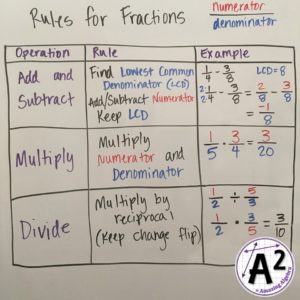I always review fractions because students claim throughout the year that they don’t know how to do them. This way I can claim that is not true because I taught them. We know they have been doing fractions since third grade, but they take some work and students would just rather skip any problem with a fraction in them. It is our job to change their mindset about fractions. They are not always the hardest problems. Everyone should LOVE them!
In this class, we do a quick warm-up, review homework from the night before, a graphic organizer or foldable as notes, practice problems in class, and then they do a homework assignment to reinforce the skills. The graphic organizer can be put in a binder (click here for a graphic organizer) or the foldable (click here for a foldable) could be glued/taped into a composition notebook for easy reference later in the year. The graphic organizer/foldable serves as notes for the lesson. This is another graphic organizer that I tell them to refer to in the future. I copy them on a colored paper and remind them to look at it when they ask me fraction questions. This is basically what it looks like:

The practice problems can be used in a number of ways. Click here for practice problems and homework. You could copy them for students and work through them in order. You could pick problems to do on the board as you see how the students are doing. Once you feel they are getting more right than wrong, you could move on to the next operation. You could have the students put the problems on small dry erase boards or have them compare answers with an assigned partner next to them.
The homework should be assigned and due the following day.
One great way to talk about fractions is to take circles and cut them in quarters or thirds. I like to put it under the document camera and project it on the board. They can visually see what adding 1/4 to 1/3 looks like. Multiplying 1/4 by 1/2 means cutting a quarter of a pie in half which is 1/8 (or folding it in half). Seeing that might help them make sense of it. Diving a fraction by 1/4 means how many quarters are in that amount? For example 1/2 divided by 1/4 is 2 because there are two quarters in a half (just place two quarters of circle on a half circle). You can show them all of that with different color circles cut into fractions. Simple right?! 🙂 I am so being sarcastic right now - mixing fractions with students is never simple. Fractions can be mind blowing. Have them think of pizza, cake, or pie. Sometimes talking about food helps.
I also love to bring money into it. All kids can think about quarters as 25 cents. If they have 1/2 a dollar and 1/4 of a dollar, how much money do they have? This is a great example because money makes sense and is easier to think about than something abstract.
I hope something I wrote helps to simplify fractions for you and your students. Good luck!